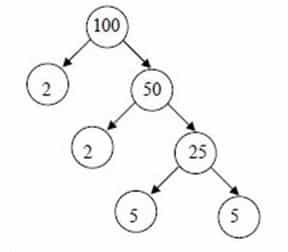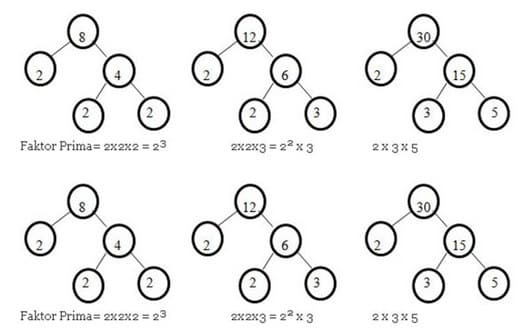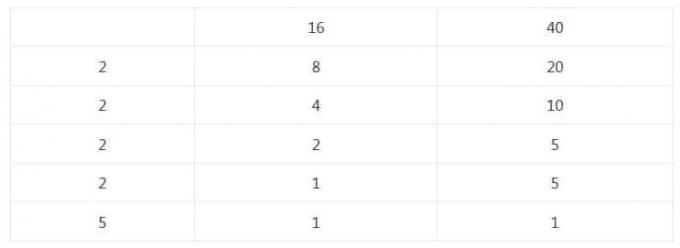How to Find LCM: Common Multiple and Prime Factorization
How to Find KPK– things about prime numbers and prime factorization are needed. Below is a complete and clear way to find the KPK and GCF accompanied by a factor tree and
When looking for KPK and GCF, you need to know about prime numbers and prime factorization, what do these two words mean?
Prime numbers are natural numbers that only have two factors, namely the number itself and 1, which includes prime numbers are {2, 3, 5, 7, 11,.. .}
Prime factorization is the decomposition of a number into the product of its prime factors. Well, to do this prime factorization you need a factor tree.
Example:
Prime factor of 100, make a factor tree

Obtained from saying 100 that is ( 2 x 2 x 2 x 5 = 2³ x 5 ), so the prime factor of 100 = 2³ x 5

Table of contents :
How to Find KPK
LCM (Least Common Multiple) of two numbers which is the smallest positive integer that can be divided by the two numbers. In finding the LCM value of a number, you can use several methods including common multiples, prime factorization, and also using tables.
1. Guild Multiples
Common multiples are equal multiples of two or more numbers. LCM is the smallest value of the common multiple of two or more numbers.
Example:
Find the LCM of 4 and 8
settlement,
Multiples of 4 = { 4, 8, 12, 16, 20, 24, 28, 32, 36, 40, 44, …}
Multiples of 8 = {8, 16, 24, 32, 40, 48, 56, …}
Common multiples of 8, 26, 24, 32, … (equal multiples of 4 and 8)
The smallest value is 8
So, the LCM of 4 and 8 is 8
2. Prime Factorization
The thing that needs to be done in finding the LCM using the prime factorization method is to be able to multiply all numbers factor and if there are the same take the largest value, if both are equal then take one of them.
Example:
Find the LCM of 8, 12, and 30
settlement,
Create a factor tree

The biggest factor 2 is 2³
Factor 3 has the same value as 12 and 30, just take one of them is 3
The factor of 5 is 1 take the value 5
So it can be seen that the LCM of 8, 12, 30 is 2³ x 3 x 5 = 120
3 Tables
Almost by looking for FPB, essentially this method has the same principle.
Example:
a. Find the LCM of the numbers 16 and 40

LCM = 2 X 2 X 2 X 2 X 5
= 24 X 5
= 80
b. Find the LCM of 10, 15 and 25

LCM = 2 X 3 X 5 X 5
= 2 X 3 X 52 = 150
Sample Questions:
1. Joko swims every 10 days, Budi swims every 15 days, while Cecep swims every 20 days. The three of them swam for the first time since March 20, 2019, when did all three swim for the second time?
settlement,
The prime factorization of 10 is 2 x 5
The prime factorization of 15 is 3 x 5
The prime factorization of 20 is 2² x 5
LCM of 10, 15, and 20 = 2² x 3 x 5 = 60 (multiply all factors, the same factor takes the largest).
So they will both swim every 60 days.
then they will swim together on 20 may 2019
How to Find FPB
The greatest common factor or what is commonly referred to as GCF is a large positive integer that can be divisible by The two numbers themselves, There are several methods to find the GCF including, Common Factor, Prime Factorization, and Table.
1. Guild Factor
The common factor is the common factor of two or more numbers and the GCF itself is the greatest value of the common factor of two or more numbers.
Example:
Find the GCF of 4, 8, and 12
Solution:
Factor of 4 = {1, 2, 4}
Factor of 8 = {1, 2, 4, 8}
Factor of 12 = {1, 2, 4, 6, 12}
The common factors are 1, 2, 4
The largest value is 4, so the GCF is 4
2. Prime Factorization
In this way you can take the same factor number, then take the smallest of 2 or more numbers.
Example:
a. Find the GCF of 4, 8, and 12
Solution:
Make a factor tree,

So, the factors of 4, 8, and 12 which are the same are 2, and the smallest is 2²= 4
Then the GCF of 4, 8, and 12 = 4.
That's the discussion about how to find the KPK, hopefully it's useful
Other Articles:
- Factor of 12: Factor, Alliance, Prime and Factorization Prime
- Greatest Common Factor: Simple Method, Factorial and Example Problem
- Prime Factors: How to Find Prime Factors and Example Problems
